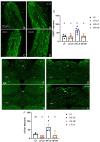This is a preprint.
Transfer with microbiota from lean donors prevents excessive weight gain and restores gut-brain vagal signaling in obese rats maintained on a high fat diet
- PMID: 38853960
- PMCID: PMC11160927
- DOI: 10.21203/rs.3.rs-4438240/v1
Transfer with microbiota from lean donors prevents excessive weight gain and restores gut-brain vagal signaling in obese rats maintained on a high fat diet
Update in
-
Transfer of microbiota from lean donors in combination with prebiotics prevents excessive weight gain and improves gut-brain vagal signaling in obese rats.Gut Microbes. 2024 Jan-Dec;16(1):2421581. doi: 10.1080/19490976.2024.2421581. Epub 2024 Nov 1. Gut Microbes. 2024. PMID: 39485288 Free PMC article.
Abstract
Background: The collection of microorganisms, mainly bacteria, which live in the gastrointestinal (GI) tract are collectible known as the gut microbiota. GI bacteria play an active role in regulation of the host's immune system and metabolism, as well as certain pathophysiological processes. Diet is the main factor modulating GI microbiota composition and recent studies have shown that high fat (HF) diets induce detrimental changes, known as dysbiosis, in the GI bacterial makeup. HF diet induced microbiota dysbiosis has been associated with structural and functional changes in gut-brain vagally mediated signaling system, associated with overeating and obesity. Although HF-driven changes in microbiota composition are sufficient to alter vagal signaling, it is unknown if restoring normal microbiota in obesity can improve gut-brain signaling and metabolic outcomes. In this study, we evaluated the effect of lean gut microbiota transfer in obese, vagally compromised, rats on gut-brain communication, food intake, and body weight. Male Sprague-Dawley rats were maintained on regular chow, or 45% HF diet for nine weeks followed by three weeks of microbiota depletion using an antibiotic cocktail. The animals were then divided into four groups (n=10 each): LF - control group on regular chow, LF-LF - chow fed animals that received antibiotics and microbiota from chow fed animals, HF-LF - HF fed animals that received microbiota from chow fed animals, and HF-HF - HF fed animals that received microbiota from HF fed animals. Animals were gavaged with donor microbiota for three consecutive days on week one and once a week thereafter for three more weeks. HF-LF animals received inulin as a prebiotic to aid the establishment of the lean microbiome.
Results: We found that transferring a LF microbiota to HF fed animals (HF-LF) reduced caloric intake during the light phase when compared with HF-HF rats and prevented additional excessive weight gain. We did not observe significant changes in the density of vagal afferents terminating in the brainstem among the groups, however, HF-LF animals displayed an increase in postprandial activation of both primary sensory neurons innervating the GI tract and brainstem secondary neurons.
Conclusions: We concluded from these data that normalizing microbiota composition in obese rats improves gut-brain communication and restores normal feeding patterns which was associated with a reduction in weight gain.
Keywords: Dysbiosis; Gut microbiota; Gut-brain axis; Microbiota Transfer; Obesity.
Conflict of interest statement
Competing interests The authors declare that they have no competing interests.
Figures







Similar articles
-
Transfer of microbiota from lean donors in combination with prebiotics prevents excessive weight gain and improves gut-brain vagal signaling in obese rats.Gut Microbes. 2024 Jan-Dec;16(1):2421581. doi: 10.1080/19490976.2024.2421581. Epub 2024 Nov 1. Gut Microbes. 2024. PMID: 39485288 Free PMC article.
-
Diet-driven microbiota dysbiosis is associated with vagal remodeling and obesity.Physiol Behav. 2017 May 1;173:305-317. doi: 10.1016/j.physbeh.2017.02.027. Epub 2017 Feb 27. Physiol Behav. 2017. PMID: 28249783 Free PMC article.
-
Potato-Resistant Starch Supplementation Improves Microbiota Dysbiosis, Inflammation, and Gut-Brain Signaling in High Fat-Fed Rats.Nutrients. 2019 Nov 8;11(11):2710. doi: 10.3390/nu11112710. Nutrients. 2019. PMID: 31717368 Free PMC article.
-
Microbiota modulation by eating patterns and diet composition: impact on food intake.Am J Physiol Regul Integr Comp Physiol. 2018 Dec 1;315(6):R1254-R1260. doi: 10.1152/ajpregu.00037.2018. Epub 2018 Sep 19. Am J Physiol Regul Integr Comp Physiol. 2018. PMID: 30230934 Review.
-
Gut bacteria interaction with vagal afferents.Brain Res. 2018 Aug 15;1693(Pt B):134-139. doi: 10.1016/j.brainres.2018.01.012. Epub 2018 Jan 31. Brain Res. 2018. PMID: 29360469 Review.
References
-
- Hales CM, Carroll MD, Fryar CD, and Ogden CL. Prevalence of Obesity and Severe Obesity Among Adults: United States, 2017–2018. NCHS Data Brief 1-8, 2020. - PubMed
Publication types
Grants and funding
LinkOut - more resources
Full Text Sources
Research Materials
Miscellaneous

